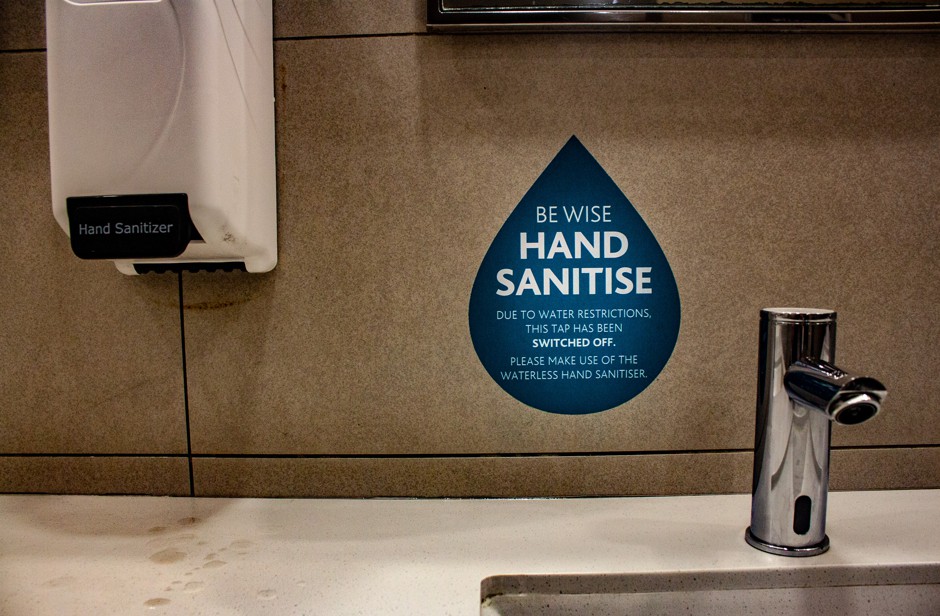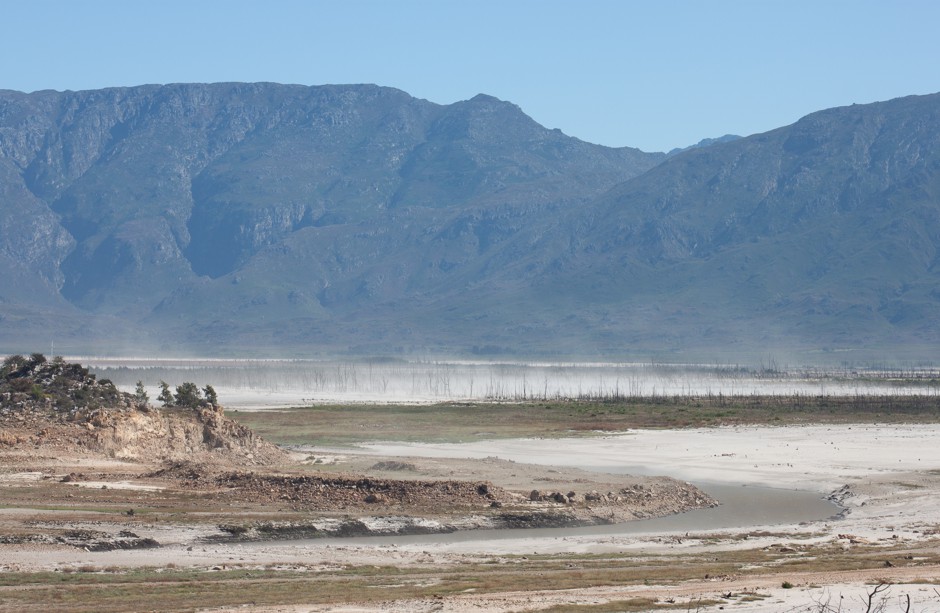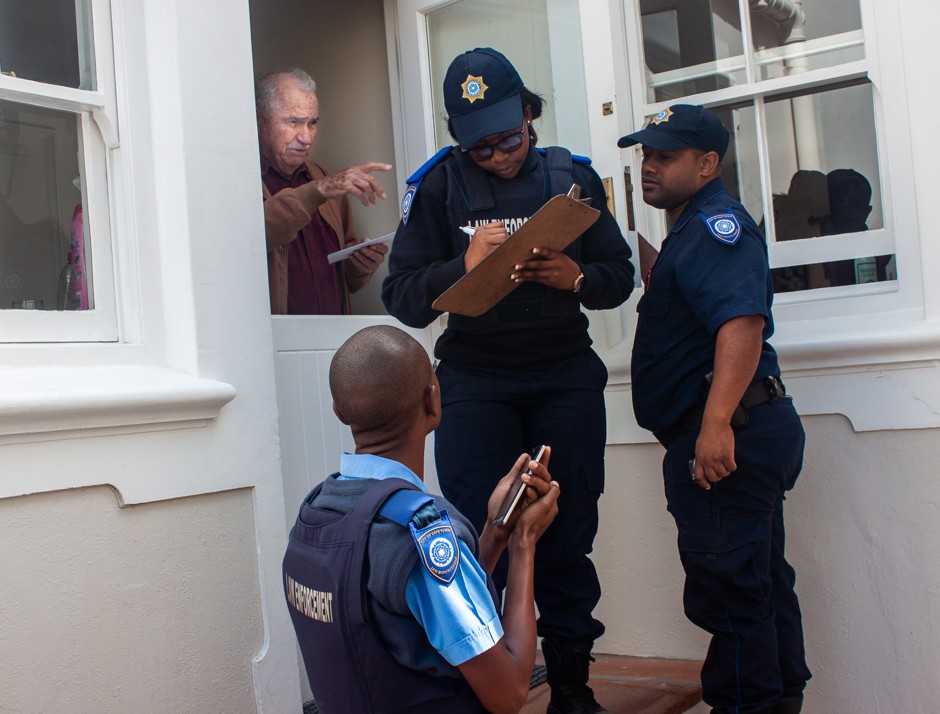How Cape Town Got to the Brink of Water Catastrophe

And how it stepped back, just in time.
This story was originally published on Circle of Blue. Travel funding for this story came from the Pulitzer Center on Crisis Reporting.
CAPE TOWN—This what a water panic looks like in a major global city.
People hoard water. They queue for hours, well into the night, to fill jugs at natural springs. Like mad Christmas shoppers, they clear supermarkets of bottled water. They descend on stockers before they can fill the shelves.
Restaurants, malls, and offices shut off bathroom faucets and install hand sanitizer dispensers. Exhortations to conserve water are plastered throughout buildings. Above one toilet stall at the University of Cape Town, a paper placard with a hand-turned dial indicates the number of uses since the last flush. “Be A Wee-Wise Water Warrior. Only Flush After 4 (No. 1’s only),” it reads.
Panic. Residents in South Africa’s second-largest city repeatedly used that word to describe the weeks after January 18, when Mayor Patricia De Lille proclaimed that the day the city would run out of water, what was called “Day Zero,” was fast approaching. The declaration hit like a blast wave.
City workers knocked holes into sewer lines so that underground water would seep in to compensate for low flows. Wealthier residents frantically drilled boreholes on their property to access groundwater and move a portion of their water use off the city grid. Well drillers reported being booked for months.
On February 1—the height of summer in the southern hemisphere, when water demand is greatest—the city clamped down, harder than any city in the world with its living standards. Officials set a target of 50 liters (13 gallons) per person, per day, for all domestic uses: cooking, bathing, toilet flushing, washing clothes. Watering lawns and scrubbing cars with city water had already been banned for months. “The abuse of water means that we will all suffer,” De Lille had warned.
The most visible symbol of the water crisis was Theewaterskloof Dam, the main drinking water source for Cape Town. The big dam and its five sister reservoirs in the Western Cape system not only supply water for drinking but also for farm irrigation. After three years of drought, the reservoirs dropped so rapidly six months ago that city authorities warned that they would shut off water to homes and businesses unless residents embraced strict water-saving practices.
The goal was to keep the reservoirs from being completely drained, which would unleash a catastrophic scenario—a major city starved of water, an economy constricted, millions of residents hauling daily water rations from sanctioned collection points, the potential for disease outbreaks and violence.
In those terrifying months earlier this year, turnouts along the R45 highway, an hour east of Cape Town, became vantage points to view the calamity. Theewaterskloof Dam, and its largely empty reservoir, lay below. Steady winds raked the empty plain on a warm April afternoon, lifting up curtains of dust. A herd of oryx grazed warily, while songbirds flitted among dead trees, their branches bleached and spiky like fish bones.
As of July, Cape Town looks to have evaded a water catastrophe, at least for this year. Residents are using substantially less water. Severe water supply restrictions instituted on agriculture and city dwellers alike, and a heroic, last-ditch conservation effort, halted the swift drop in reservoir levels.
Winter rains are now providing some relief. The amount of water stored in the reservoirs more than doubled in the last month, and rivers in the Western Cape swelled in downpours. Snow graced the mountain peaks. The start of the wet season this year is more promising than any of the last three.
The near-death experience, though, is revealing for the gorgeous seaside city at the southern tip of Africa. And it offers lessons in the immense challenges that fast-growing and drought-prone cities all over the world face in making adequate supplies of water available in the era of intensifying hydrological disruption. Other big cities also contend with severe water shortages, some that prompt civic violence. They include Beijing and São Paulo; Chennai, New Delhi, and Bangalore in India; Karachi, Amman, and Mexico City.
The Western Cape drought and the subsequent receding of Cape Town’s reservoirs exposed individuals and businesses to months of hardship and anguish. It laid bare the inadequacies of institutions, laws, and leadership to recognize and respond quickly enough to severe water shortage. The drought magnified the city’s racial and economic divides, which are legacies of apartheid.
It also unveiled the precarious risk calculations that local and national authorities charged with safeguarding Cape Town from just such an emergency had to make. Those authorities and their agencies have been aware for years of vulnerabilities in the Western Cape water system. They even drew up careful plans to address weaknesses. Yet after more than a decade of planning, and regular meetings to discuss drought-related risks, they determined that they could keep delaying the date at which they needed to invest in new water supplies. As it turns out, they waited too long. Severe drought took hold and the Cape Town region slid to the brink of catastrophe.
“The planning’s been there. The planning’s been there for a long time,” explained Kirsty Carden, a researcher at the University of Cape Town’s Future Water Institute. “But in reality, water resources managers plan for nothing more than 98 percent assurity”—or a 2 percent chance of a water shortfall—“so they’re not planning for anything that’s going to take them out of the normal planning regime, because there are other priorities for spending for local and national government, particularly in a country like South Africa.”
A city on edge
Three police vehicles pull into a shopping center parking lot in Wynberg, a leafy, middle-class district of Cape Town.
“This is a place we always monitor,” says Warren Brandt, a take-charge officer on the lookout for water waste. Yes, water waste. Brandt says that the parking lot is a known depot for taxi washing, which is now illegal under city bylaws. In dystopian futures, this a scenario that sci-fi authors envision.
Leading the convoy, Brandt’s vehicle pulls up next to a minibus. A man in a knit cap and orange reflective vest peers sheepishly from beside the vehicle, a bucket at his side. “This is not the first time we’ve fined him,” Brandt says while another officer writes a R500 ticket (roughly $35).
The law enforcement department stepped up its policing of water waste in January, when the water crisis in Cape Town reached a crescendo. “I mean, that was really the crisis point at which panic set in,” Ian Neilson, the city’s deputy mayor, told Circle of Blue during an interview in a City Hall conference room.
The Day Zero announcement prompted panic, but Mayor De Lille’s authority did not last long after it. The following day, owing to unrelated charges from her party of mismanagement and corruption, the city council revoked her responsibility to oversee drought response, and Neilson took command.
Neilson said he had two immediate tasks: to drive down water use, which was the only response the city could muster in the short term, and to improve communication with residents. Hopes of a “quick win”—rapidly boosting supply from a fleet of small-scale desalination plants—proved to be illusory after consultation with World Bank experts, Neilson said. Acquiring, delivering, and installing the plants would have been too expensive, too slow, and useless over the long-term because the cost per unit of water was so high.
Day Zero did not mean no water would flow into Cape Town; it meant the city would dramatically reduce demand by controlling the points at which people could access water. That was to be achieved by cutting off households and requiring them to queue at more than 200 public collection sites. It was conservation by extreme rationing, with a goal of cutting city demand to 350 million liters (about 92 million gallons) a day. If it had to be implemented, the Day Zero plan would have extended supplies by three months, buying time until the return of the rainy season, which runs from May until September.
That made communication all the more important. Sending clear messages was necessary to keep residents aligned with the water-saving mission. For Neilson, it meant putting out as much information as possible on dam levels, water consumption, and the progress of infrastructure projects that will, eventually, bring new water to the city.
Day Zero was always a moving target. City officials dutifully updated the projections each week based on the previous week’s consumption. Use less, and Day Zero retreated. Use more, and it moved forward.
“People will say, ‘I’ve had enough. I want a decent bath again,’” Neilson said, explaining the need to reinforce the conservation gospel. “We have to keep the message up. We have to keep them on board. The only way I see that can be achieved is that we have to be open and frank and truthful. We put out the information, good or bad. The fact that consumption went up 5 percent this week [in April], we put it out, we said it.”
After the January panic, the Day Zero date began to move farther and farther into the future. Demand, which had been stuck around 600 million liters a day, fell closer to 500 million as restrictions and higher water rates started to bite. If residents didn’t adhere to water-use limits on their own, the city put them on a leash. Between October 2017 and May 2018, city workers installed more than 46,170 “water management devices” that throttled the flow of water into homes that used more than 10,500 liters (or about 2,800 gallons) a month.
Then at the end of February, the farm sector, which was allocated one-third of the water from the Western Cape system, reached its limit. With farms not drawing from the reservoirs anymore, the pace of decline slowed.
Cape Town also received an unexpected bonus. The Groenland Water User Association, a farmers’ group, announced in early February that it would release water from its own dams into city reservoirs. That donation amounted to roughly two weeks of municipal demand.
‘Everything relies on’ reducing demand
Ensuring that the Day Zero scenario never came to pass was the task of a group of local, provincial, and national government officials who began detailed discussions about water supply in the Western Cape more than a decade ago. The need was obvious: The Cape Town metropolitan region was growing by more than 65,000 new residents annually. And climate change scenarios forecasted that the region would steadily get drier and warmer.
On September 20, 2007, the Strategy Steering Committee (SSC) met in the Cape Town office of Ninham Shand, a South African engineering consultancy that provided technical analysis to the group. Seventeen people were present at that first meeting, but attendance at later gatherings would grow to roughly 30 as more agencies became involved.
The SSC’s purpose was to guide the region’s response to findings from the Reconciliation Strategy Study, an influential report published in 2007 that projected supply and demand from the Western Cape Water Supply System through 2030.
The assessment found that under a low-growth scenario, considering population and economic development, the system would need an infusion of water after 2015. In the high-growth scenario, that date moved forward to 2011. The study also acknowledged a fundamental risk for the region’s water supply: It was too dependent on reservoirs and thus vulnerable to a long drought, especially if climate change resulted in less rainfall.
In its eight years, the committee would wrestle with two main questions: When would the Western Cape system need to be augmented? And what would was the best way to do so? The options under consideration were largely the same suite of choices that Cape Town is evaluating today: tapping groundwater basins, allowing rains to soak into aquifers, cleaning municipal wastewater for reuse, diverting additional water from rivers, clearing invasive plants from mountain catchments, and removing salt from ocean water to make it potable.
A crucial variable was Cape Town’s demand. Because the city accounted for roughly three-fifths of the system’s water use, a large increase or decrease in urban demand would dictate the speed with which new sources of water were needed.
“Everything relies on this,” Paul Rhode of the Cape Town Water Department said at the September 2007 meeting. Tracking changes in demand was labelled an “urgent action.”
After seeing the results of the strategy study and as part of a deal with the national government over a just-completed reservoir in the Western Cape system, Cape Town authorities pledged, in 2007, to slow the growth in water demand and, if possible, reduce it. They aimed to do so by patching leaks, installing new meters, reusing wastewater, and decreasing pressure in the distribution pipes, which would cut the flow rate to household taps.
The approach was partly a matter of picking low-hanging fruit, but also a way to delay as long as possible the need to build expensive infrastructure projects like desalination. Thriftiness was seen as a virtue.



Comments
Post a Comment